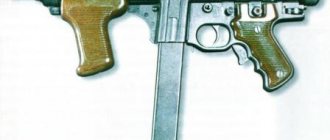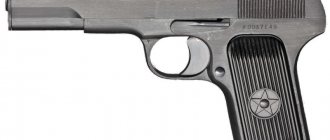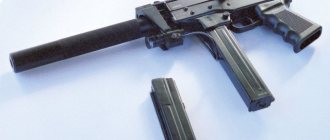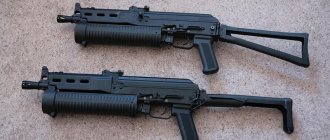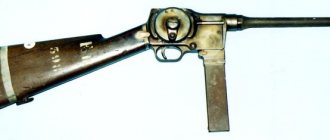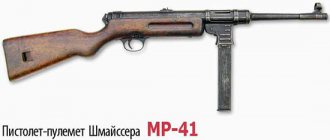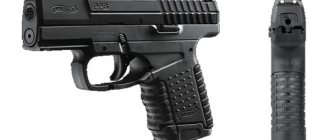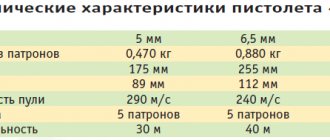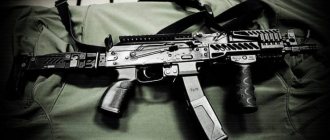M3 and M3A1 submachine gun
M3 "Grease gun" submachine gun, right view.
M3 “Grease gun” submachine gun, left view, butt extended to firing position.
M3 “Grease gun” submachine gun, incomplete disassembly.
M3A1 submachine gun. The enlarged window cover for ejecting cartridges and the flash suppressor on the barrel are clearly visible.
A rare variant of the M3A1 submachine gun with an integral silencer, designed for special operations.
Characteristics
Caliber:
.45ACP (also 9x19mm Luger/Para for M3A1)
Weight:
3.7 kg
Length (stock folded/opened):
570 / 745 mm
Barrel length:
203 mm
Rate of fire:
450 rounds per minute
Magazine capacity:
30 rounds
Effective range:
50 meters
The M3 submachine gun, also known as the Grease gun (a slang name among soldiers for “grease can”), was developed by the American company General Motors Corp as a cheaper replacement for the Thompson system submachine guns (M1928 and M1), which were distinguished by their high cost and labor-intensive manufacturing. Production of the M3 began in December 1942, and an improved (and simplified) modification, the M3A1, was released at the end of 1944. M3A1 submachine guns remained in service with the US infantry until approximately the early 1960s, and in tank forces until the early 1980s, and were also exported. They were used during World War II, as well as the wars in Korea and Vietnam.
The M3 submachine gun uses blowback automatic action and fires from an open bolt. The body of the submachine gun was made of stamped steel, the barrel was installed in a special coupling, which also served as the front cover of the receiver. A distinctive feature of the M3 is its distinctive cocking handle, located below the barrel line and cocked by turning it approximately 1/4 turn back. Since the bolt cocking unit turned out to be insufficiently reliable, it was eliminated in the M3A1 modification, replacing the cocking handle with a hole in the bolt body, which the shooter grabbed with his finger to pull the bolt back. To achieve this, they also increased the size of the window for ejecting cartridges, through which the bolt was cocked. The spring-loaded cover of the window for ejecting cartridges also served as a fuse, in the closed position blocking the bolt in the forward or rear position. Sights are simple, non-adjustable, mounted on the receiver. Retractable buttstock made of steel wire. Once removed from the weapon, the right rod of the butt could be used as a cleaning rod; in addition, a bracket was made in the rear of the M3A1 butt, making it easier to load magazines (sending a cartridge into the magazine). Later M3A1 submachine guns also had a conical flash suppressor. The M3A1 could be converted to use the 9x19mm NATO cartridge by replacing the barrel, bolt and installing an adapter in the magazine receiver, allowing the use of magazines from the English 9mm Sten submachine gun.
The slang name "Grease gun" apparently comes from the fact that these submachine guns required constant lubrication to ensure smooth operation of the mechanisms. To do this, there was a small built-in oiler in the handle of the weapon, which was closed with a screw cap at the bottom of the handle. In addition, the M3 submachine gun was purely visually reminiscent of automobile oil syringes, which also contributed to the spread of its unofficial name.
Benelli M3 Specifications
The performance characteristics of the Benelli M3 shotgun are as follows:
- Operating principle: Benelli inertial system, variable-trajectory trigger, possibility of switching to manual reloading.
- Caliber: 12.
- Chamber: 76 magnum.
- Stock and handguard: made of technopolymer.
- Butt length: 355 mm.
- Died at the heel: 36.5 mm.
- Killed in the ridge: 38 mm.
- Receiver: “Ergal”, anodized, black, matte.
- Sights: made of red fiber optics.
- Fuse: transverse with a red groove corresponding to the “fire” position.
- Trigger guard: "Ergal".
- Butt pad: rubber.
- Magazine: 6 magnum / 7 standard.
- Weight: about 3480 g.
Gepard M1/M2/M3 large-caliber sniper rifle
Details Category: Hungary Date of publication 06/08/2013 17:22 Author: Super User The large-caliber (anti-material) sniper rifle Gepard (Cheetah) was developed in the late 80s of the XX century by the Hungarian military engineer, famous developer of small arms Ferenc Földi (Ferenc Földi, currently a retired colonel, in 2006 he was awarded the Hungarian Order of Merit (Knight's Cross) for services to the Hungarian Republic).
Gepard can rightfully be considered the first large-caliber sniper rifle in the full sense of the word among the countries of the then socialist camp, in particular the countries participating in the Warsaw Pact, especially during its development and creation, the Soviet-made anti-tank rifles PTRD and PTRS from the Second World War were taken as the basis world war.
The main purpose is the destruction and disabling of lightly armored and unarmored technical means (material parts) of the enemy: infantry fighting vehicles, vehicles, radars, airplanes and helicopters stationed at sites and airfields, combat robots, etc., as well as armed terrorists, dangerous criminals etc. hiding behind various covers that cannot be penetrated by bullets from conventional sniper rifles.
The first rifle of the Gepard series, designated Gepard M1, was finally developed in 1990, and already in 1991, after all the necessary tests, its small-scale mass production began.
But at the same time, due to the collapse of the USSR, the Warsaw Pact Organization (a military alliance of the socialist states of Europe) ceased to exist. Former social countries, one after another, announced a change in their political system, ideology, foreign policy priorities and military cooperation, and therefore, the rifle turned out to be almost unclaimed and despite the fairly high tactical and technical characteristics of its later versions, none of its modifications are still available has not been officially adopted by any country in the world except Hungary, where several dozen units of its various variants are in service with the armed forces and police special forces, and India, where a variant of the M6 Lynx rifle is in service with special units of the army and police.
Tactical and technical characteristics of the Gepard large-caliber sniper rifle
| Rifle type: | large-caliber sniper |
| A country: | Hungary |
| Operating countries: | Hungary, Türkiye, Croatia, India |
| Developer: | Ferenc Föld |
| Year of development: | 1987 — 1990 |
| Years of production: | 1991 — 2000 |
| Manufacturer: | |
| Options: | M1; M1A1; M2; M2A1; M3; M4; M4SA1; M5; M6 Lynx |
| Length, mm: | M1 and M1A1 - 1570; M2 - 1536; M2A1 - 1266; M3 - 1880 |
| Barrel length, mm: | M1, M1A1, M2 - 1100; M2A1 - 830; M3 - 1480 |
| Caliber, mm: | 12,7 |
| Ammunition: | M1 and M1A1 - cartridge 12.7x108 mm, M2 - 12.7x108 mm and .50 BMG, M3 - 14.5x114 mm |
| Magazine capacity, pcs: | M1, M1A1 - single-shot, M2 and M3 - detachable box magazine for 5 or 10 rounds. |
| Initial bullet speed, m/s: | M1 and M1A1 - 842; M2 - 838; M2A1 - 785; M3 - 1000 |
| Principle of operation: | longitudinally sliding bolt, automatic based on barrel recoil |
| Sights: | standard equipment - x12 optical sight |
| Effective firing range, m: | M1 and M1A1 - 2000; M2 - 1200; M2A1 - 1000; M3 - 2500 |
| Weight, kg (without cartridges and sight) | M1 - 19; M1A1 - 21.5; M2 - 16; M2A1 - 15; M3 - 20 |
Submachine gun m3a1 Grease Gun photo
The m3a1 Grease Gun submachine gun photo the Grease Gun due to its appearance , was a development dating back to 1944 as an improved version of the M 3 . Developed by a team of designers (R. Stadler, D. Heide, F. Simson) as a replacement for the Thompson submachine gun. Back in 1939, the US Ordnance Department made the first preparations to find a new submachine gun to replace the expensive and too costly to manufacture Thompson submachine gun. In accordance with this, various American and foreign weapons were tested at the Aberdeen Proving Ground. However, none of them could fully satisfy the requirements. In general, in terms of accuracy and reliability, 9 mm caliber weapons turned out to be better than those with 45 ACP caliber. They were lighter, more accurate and technically simpler. Their cartridge was the most common ammunition for pistols and submachine guns in the world.
US Submachine Gun. Calibcr.45, M3
Nevertheless, the department of artillery, technical and material supply clung to the “powerful” .45 ACP caliber cartridge, the bullet of which, due to its mass, had the best stopping effect. Ultimately, those in charge came to the conclusion that it was likely that future submachine guns would be made primarily from pressed sheet steel. Compared to all .45 ACP caliber weapons tested at that time, when tested for dust and contamination, the T-20 model of the Inland Division of General Motors performed best. Its two parallel return springs, which were not in contact with the inner surface of the receiver, remained insensitive to contamination.
Advantages and disadvantages
The advantages of the Benelli M3 include:
- possibility of recharging in two ways;
- any low-quality cartridge can be changed quickly, for which it is enough to pull the bolt by the handle;
- soft pump action;
- shoots shot and bullets;
- the automation works smoothly, the security system is reliable, and the gun is not difficult to maintain.
There are also some negative aspects:
- the gun is more intended for private use and is of little use for hunting;
- not the most balanced gun, especially when fully loaded;
- far located forend;
- strong recoil;
- Factory-made cartridges should be used.
Modifications
Benelli M3 shotgun modifications:
- Basic model Benelli M3 Super 90. The basic modification can be equipped with various types of buttstocks, solid hunting type and with a pistol grip and buttstock separately. Standard models have an 8-round tubular magazine.
- Benelli M3T Tactical combat shotgun. A variant of the Benelli M3 shotgun for police and combat use. Available with a folding stock, often marked without the "Super 90" designation. The letter “T” in the name means “Tactical.” It should be taken into account that the tubular metal stock folds upward and, when folded, may partially overlap the sighting devices. Also, the Tactical shotgun can be with a fixed butt and with a diopter rear sight mounted on the receiver.
- Benelli M3 Shorty. A shotgun with the shortest possible barrel and a magazine with a pistol grip without a stock. Can be equipped with an under-barrel flashlight and a collimator sight.
- Benelli M3 Kromo. It is distinguished by a special surface treatment that protects against water and the environment.
The Benelli M3 shotgun is considered universal in its design. Various cartridges can be used - magnum, sports and traumatic, which, by the way, are not accepted by semi-automatic devices. Great for self-defense, sport shooting and hunting.
Characteristics of the Denix D7/1313 M3 Grizz Gun (MMG) submachine gun model
| Type | Weight and size layout |
| Manufacturer | Denix |
| Combat prototype | Submachine gun / M3 / M3A1 / Grease gun (USA) |
| Caliber | No |
| Number of charges | No |
| Possibility of disassembly/assembly | No |
| Size | Length - 590 mm |
| Weight | 3145 grams |
| Housing material | Metal |
| Stock material | Metal |
| Color | Black |
| Peculiarities | Series - “World Wars I and II 1914-1945”, removable stock, detachable magazine |
| Country of Origin | Spain |
| Equipment | Weight and size model, packaging, brief documentation, copy of the certificate (at the buyer’s request) |
| Product weight | 3.14 kg |
| certificate |
Model of the Denix D7/1313 M3 Grease gun (MMG) submachine gun buy in the Popadiv10 online store. Model of the Denix D7/1313 M3 Grease gun (MMG) submachine gun at a low price of RUB 12,365. You can pay for your order by mail upon receipt in any part of the Russian Federation. Before placing an order, be sure to check the price and contents of the product by phone (during business hours) or by e-mail and feedback system (at any time convenient for you).
The information on the product “Model of a submachine gun Denix D7/1313 M3 Grease gun (MMG)” is for informational purposes only and is not a public offer determined by the provisions of Article 437 of the Civil Code of the Russian Federation; characteristics, appearance, color and equipment can be changed by the manufacturer without notifications.
